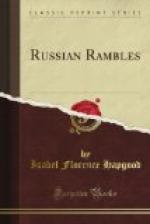When the Emperor was in St. Petersburg, he drove about freely every day like a private person. He was never escorted or attended by guards. In place of a lackey a Kazak orderly sat beside the coachman. The orderlies of no other military men wore the Kazak uniform. Any one acquainted with this fact, or with the Emperor’s face, could recognize him as he passed. There was no other sign; even the soldiers, policemen, and gendarmes gave him the same salute which they gave to every general. At Peterhoff, in summer, he often drove, equally unescorted, to listen to the music in the palace park, which was open to all the public.
On occasions of state or ceremony, such as a royal wedding or the arrival of the Shah of Persia, troops lined the route of the procession, as part of the show, and to keep the quiet but vigorously surging masses of spectators in order; just as the police keep order on St. Patrick’s Day in New York, or as the militia kept order and made part of the show during the land naval parade at the Columbian festivities in New York. On such occasions the practice as to allowing spectators on balconies, windows, and roofs varied. For example, during the Emperor’s recent funeral procession in Moscow, roofs, balconies, open windows, and every point of vantage were occupied by spectators. In St. Petersburg, the public was forbidden to occupy roofs, balconies, lamp-posts, or railings, and it was ordered that all windows should be shut, though, as usual, no restriction was placed on benches, stools, and other aids to a view. A few days later, when the Emperor Nicholas II. drove from his wedding in the Winter Palace to the Anitchkoff Palace, roofs, balconies, and open windows were crowded with spectators. I saw the Emperor Alexander III. from an open balcony, and behind closed windows.
On the regular festivals and festivities, such as St. George’s Day, New Year’s Day, the Epiphany (the “Jordan,” or Blessing of the Neva), the state balls, Easter, and so forth, every one knew where to look for the Emperor, and at what hour. The official notifications in the morning papers, informing members of the Court at what hour and place to present themselves, furnished a good guide to the Emperor’s movements for any one who did not already know. On such days the approaches to the Winter Palace were kept open for the guests as they arrived; the crowd was always enormous, especially at the “Jordan.” But as soon as royalties and guests had arrived, and, on the “Jordan” day, as soon as the Neva had been blessed, ordinary traffic was resumed on sidewalks of the Winter Palace (those of the Anitchkoff Palace, where the Emperor lived, were never cut off from public use), on streets, and Palace Square. Royalties and guests departed quietly at their pleasure.




